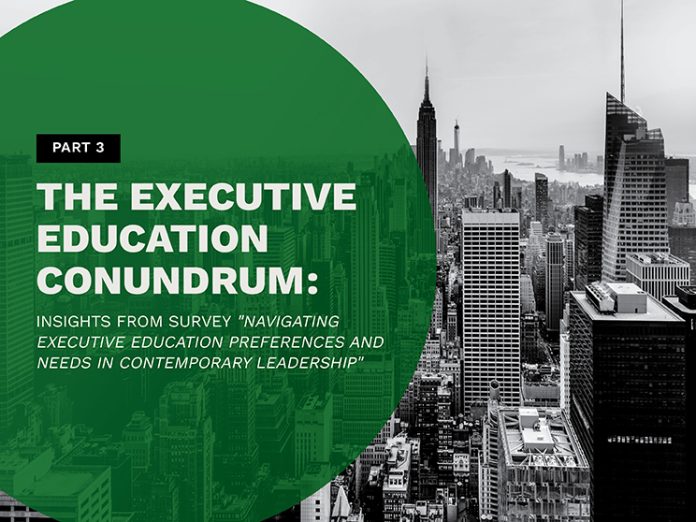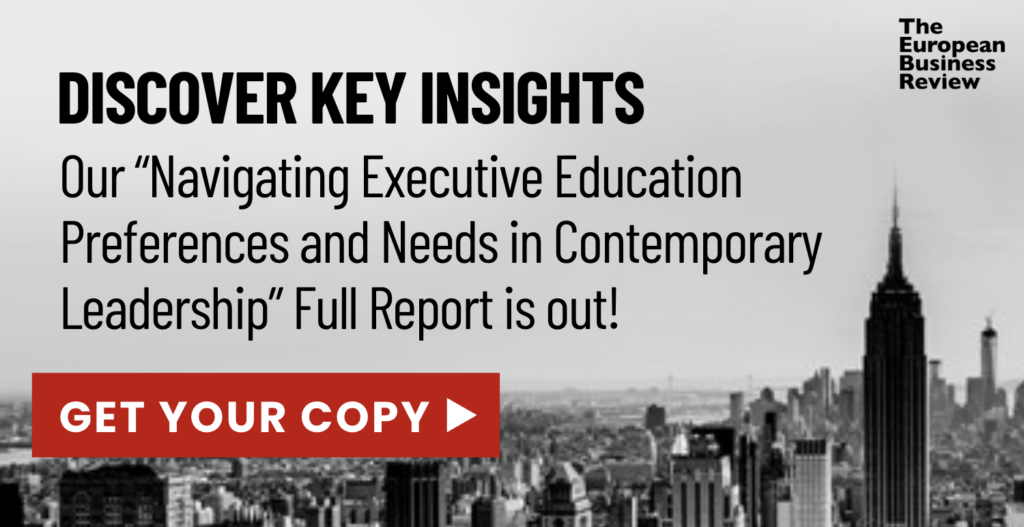Read our first report here.
Read our second report here.
- Executive education formats play a pivotal role in shaping professionals’ learning journeys and career trajectories.
- Our survey delves into participant preferences, revealing a diverse array of favored formats as online programs and part-time courses emerge as popular choices, offering flexibility and accessibility.
- Short-duration courses also garner significant interest, providing focused insights in condensed timeframes.
- Understanding these preferences is crucial for institutions to tailor programs that meet the evolving needs of professionals.
I. Introduction
Executive education formats represent the structural framework within which professionals sculpt their paths of continuous learning, influencing not just the acquisition of knowledge but also the trajectory of their careers. These formats encompass a diversity of offerings, from part-time programs tailored to accommodate the demands of busy schedules, to intensive short-duration courses designed to impart focused insights, and the adaptable nature of online platforms which afford professionals the flexibility to engage with educational content at their own pace and convenience.
The importance of understanding and appreciating these formats cannot be overstated, as they wield significant influence over the accessibility, efficacy, and pertinence of executive education programs. In today’s multifaceted business landscape, characterized by rapid changes and evolving demands, professionals seek education pathways that not only equip them with relevant skills and knowledge but also align with their individual circumstances and aspirations. By embracing the diverse array of executive education formats, institutions can effectively cater to the varied needs of professionals, ensuring that learning experiences are not only enriching but also tailored to address the complexities of modern-day challenges in the professional sphere.
II. Understanding Participant Preferences
A. Analysis of survey responses regarding favored executive education formats
A crucial aspect of enhancing executive education programs lies in understanding the preferences and priorities of participants. In this section, we delve into the analysis of survey responses to uncover insights into favored executive education formats. By examining participants’ preferences, we gain valuable insights into the factors driving their choices, informing institutions and educators on how to tailor programs to better meet the diverse needs of professionals navigating the contemporary business landscape.
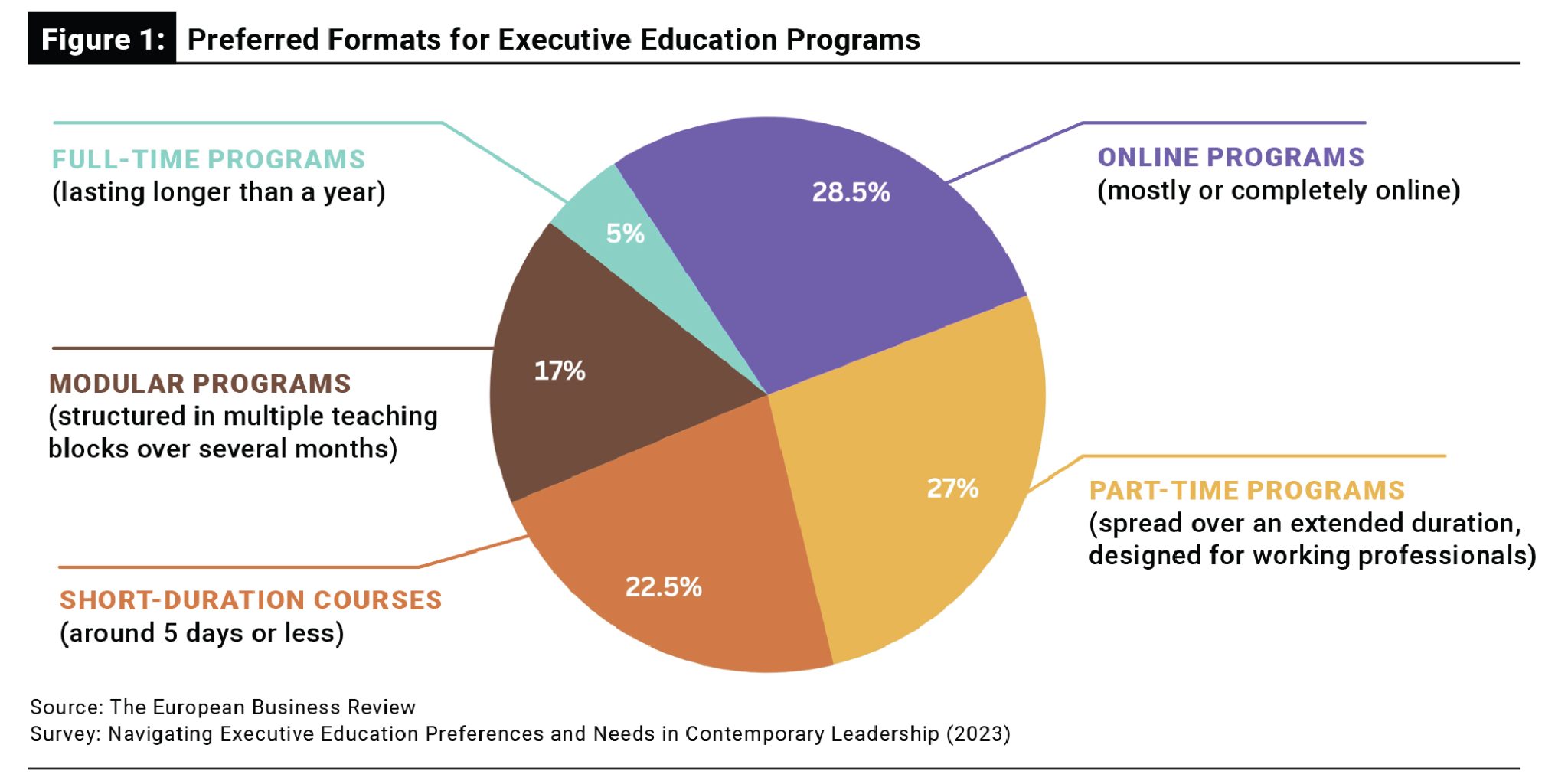
- 28.5% Online programs (mostly or completely online)
Online programs emerge as a popular choice, with more than a quarter of respondents favoring this format. This preference for online learning underscores the growing importance of flexibility and accessibility in today’s fast-paced professional world. Professionals appreciate the convenience of being able to access educational content from anywhere, at any time, allowing them to balance their learning with their busy schedules.
- 27% Part-time programs (spread over an extended duration, designed for working professionals)
Part-time programs also garner significant interest, mirroring the demand for flexibility among working professionals. With a similar percentage of respondents favoring this format as online programs, it’s evident that professionals value the opportunity to pursue education while still fulfilling their work and personal commitments. Part-time programs provide the flexibility to balance professional development with other responsibilities, making them an attractive option for many.
- 22.5% Short-duration courses (around 5 days or less)
Short-duration courses emerge as another popular choice, capturing the interest of nearly a quarter of respondents. This preference highlights the appeal of intensive learning experiences that offer focused insights in a condensed timeframe. Professionals value the opportunity to acquire new skills or knowledge quickly and efficiently, without the need for a long-term commitment.
- 17% Modular programs (structured in multiple teaching blocks over several months)
Modular programs, characterized by their segmented structure over several months, attract a moderate level of interest among respondents. While not as popular as online or part-time programs, modular formats offer professionals the flexibility to engage with educational content in manageable chunks, allowing for a more personalized learning experience tailored to individual schedules and preferences. - 5% Full-time programs (lasting longer than a year)
Full-time programs, requiring a substantial time commitment of over a year, represent the least preferred option among respondents. This lower preference may reflect the challenges associated with balancing full-time education with existing work and personal commitments. While full-time programs offer immersive learning experiences, they may be less feasible for professionals already established in their careers.
The survey results highlight a diverse range of preferences among participants when it comes to executive education formats. From the flexibility of online and part-time programs to the intensity of short-duration courses and the structured approach of modular programs, professionals seek formats that align with their individual needs, preferences, and lifestyles. Understanding these preferences is essential for institutions and educators in designing executive education programs that cater to the evolving demands of today’s professionals.
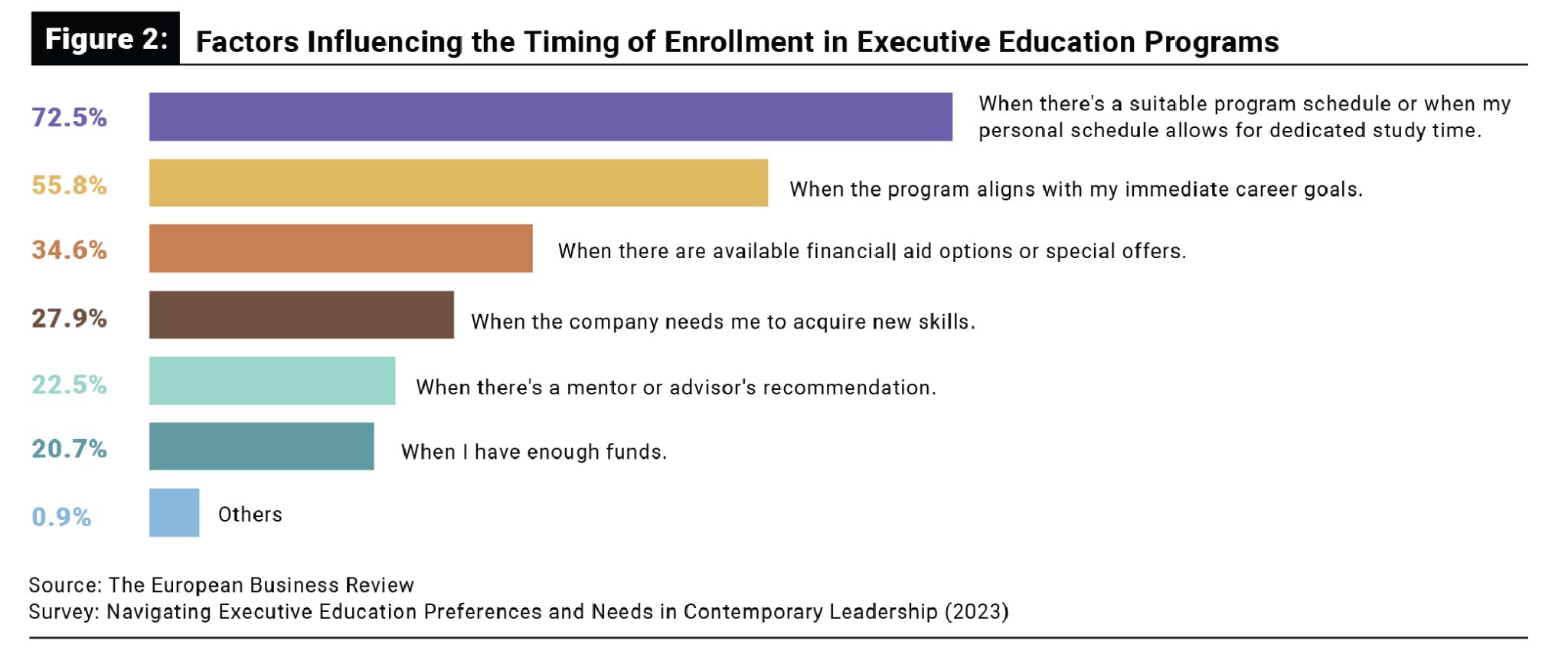
Institutions must also remain agile, adapting to emerging trends to deliver impactful executive education experiences. The survey results also shed light on participants’ decision-making process regarding the timing of commencing an executive education program. A significant majority (72.5%) prioritize a suitable program schedule or personal study time availability, underlining the importance of flexibility in program timing. Over half of respondents (55.8%) consider program alignment with immediate career goals as a crucial factor, while financial considerations also play a significant role, with 34.6% indicating the availability of financial aid options or special offers as influential in their decision-making. Additionally, organizational needs drive decisions for 27.9% of participants, highlighting the importance of professional development in the workplace. While mentor or advisor recommendations (22.5%) and personal financial readiness (20.7%) are less frequently cited factors, they still carry weight in participants’ decision-making processes.
These results underscore the complex nature of executive education program selection and emphasize the need for institutions to offer flexible, career-aligned programs with diverse financial aid options to meet the varied needs of professionals.
B. Overview of different executive education structures and delivery methods
When it comes to executive education, there’s no one-size-fits-all approach. Institutions and educators employ a variety of structures and delivery methods to meet the diverse needs and preferences of professionals.
- In-person Workshops and Seminars
In-person workshops and seminars provide participants with immersive learning experiences facilitated by expert instructors. These sessions often emphasize interactive discussions, case studies, and real-world applications, allowing participants to engage directly with course material and their peers. While in-person formats offer valuable networking opportunities and immediate feedback, they may require participants to travel and allocate dedicated time for attendance. - Online Programs
Online programs leverage digital platforms to deliver educational content in a virtual environment. Participants can access lectures, assignments, and discussions online, offering flexibility in terms of time and location. Online programs often incorporate multimedia resources, interactive exercises, and discussion forums to enhance engagement and collaboration among participants. The asynchronous nature of online learning allows professionals to balance their education with work and personal commitments, making it a popular choice for busy professionals.
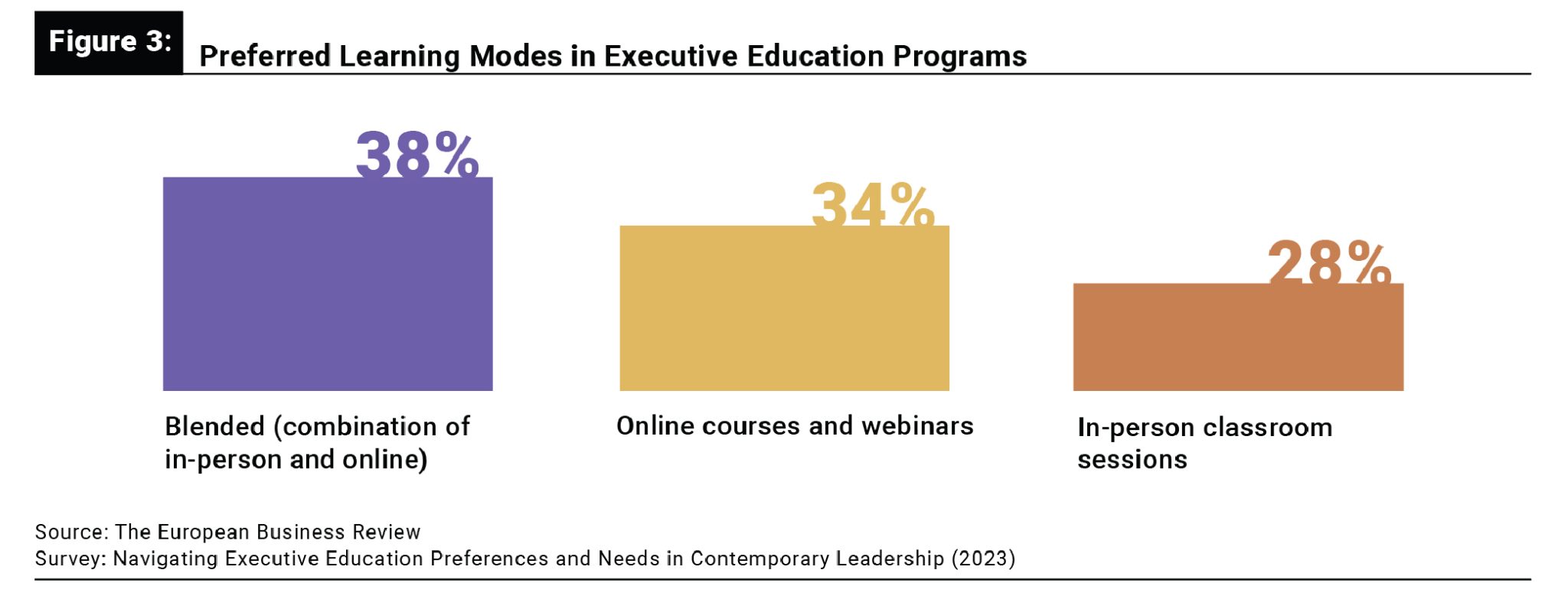
- Part-time Programs
Part-time programs are designed to accommodate the schedules of working professionals by spreading coursework over an extended duration. Participants typically attend classes in the evenings or on weekends, allowing them to continue working while pursuing their education. Part-time programs offer the depth and rigor of traditional academic programs, with the added flexibility of evening or weekend classes. This format is particularly well-suited for professionals seeking to balance career advancement with ongoing professional development. - Short-duration Courses
Short-duration courses offer intensive learning experiences packed into a condensed timeframe, typically lasting around five days or less. These courses focus on specific topics or skill areas, providing participants with targeted insights and practical knowledge that can be immediately applied in their professional roles. Short-duration courses appeal to busy professionals seeking to acquire new skills or knowledge quickly and efficiently, without the need for a long-term commitment. - Modular Programs
Modular programs are structured in multiple teaching blocks spread over several months. Participants attend short, intensive sessions at regular intervals, allowing them to engage with course material in manageable chunks. Modular programs offer the flexibility to balance education with work and personal commitments, while also providing opportunities for deeper exploration of topics over time. This format is ideal for professionals seeking a structured yet flexible approach to executive education.
By offering a diverse array of structures and delivery methods, institutions can cater to the varied needs and preferences of professionals seeking executive education opportunities. Whether through in-person workshops, online programs, part-time courses, short-duration sessions, or modular formats, the goal remains the same: to provide high-quality education that empowers professionals to excel in their careers and drive organizational success.
III. Comparative Analysis of Executive Education Formats
Executive education formats come with their own set of strengths and limitations, each catering to different learning styles and preferences. When evaluating executive education formats, it’s essential to consider their inherent strengths and limitations, as each format caters to different learning styles and preferences.
In-person Workshops
- Pros: In-person workshops offer immersive learning experiences where participants can engage directly with instructors and peers. They foster collaboration, encourage hands-on activities, and facilitate networking opportunities, enhancing overall learning outcomes.
- Cons: Despite their benefits, in-person workshops may require participants to travel, incurring additional costs and time commitments. Additionally, geographical constraints may limit accessibility for professionals from diverse locations.
Online Courses
- Pros: Online courses provide unparalleled flexibility, allowing participants to access educational content from anywhere with an internet connection. They offer asynchronous learning opportunities, enabling professionals to pace their studies according to their schedules.
- Cons: While online courses offer flexibility, they may lack the immediacy of face-to-face interactions. Participants may miss out on spontaneous discussions and immediate feedback, necessitating stronger self-discipline and motivation to stay engaged.
Blended Learning
- Pros: Blended learning combines the best of both worlds, integrating in-person and online components to offer a flexible and dynamic learning experience. It accommodates different learning styles and preferences, catering to diverse participant needs.
- Cons: Implementing blended learning requires careful planning and coordination to ensure seamless integration of in-person and online activities. Logistical challenges may arise in terms of scheduling, resource allocation, and technology integration.
According to the survey results, a significant portion of respondents expressed concerns about the lack of flexibility (60.9%) in program schedules, indicating that this factor might discourage them from enrolling in executive education programs. This underscores the importance of flexibility in accommodating professionals’ busy schedules and commitments. Additionally, 59% of participants highlighted the high cost associated with executive education programs as a potential deterrent. This underscores the significance of affordability as a determining factor in the effectiveness of different formats.
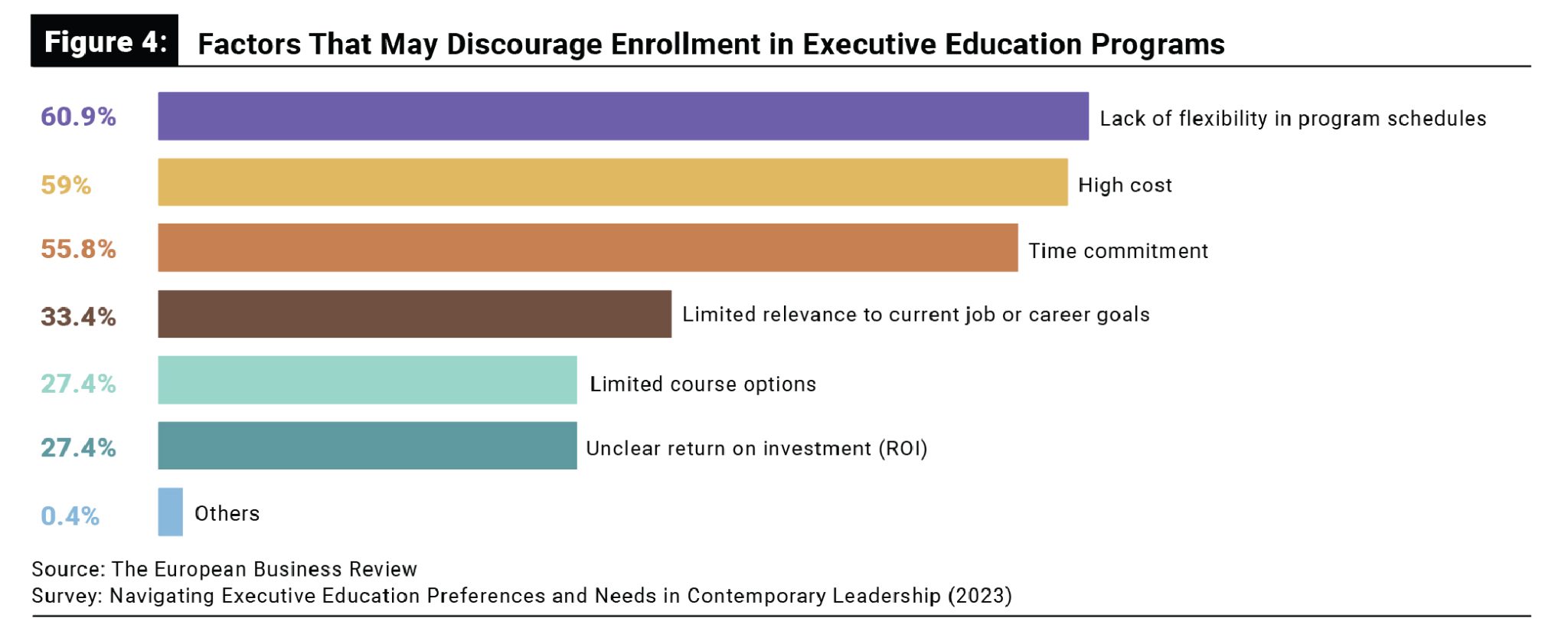
In response to these concerns, online courses emerge as a popular choice among participants. These courses offer flexibility in terms of time and location, addressing the issue of inflexible program schedules. Professionals can access educational content remotely, allowing them to balance their learning with work and personal commitments, thus enhancing the effectiveness of online formats. Moreover, online platforms often provide a range of pricing options, including more affordable alternatives compared to traditional in-person programs. This affordability factor contributes to the perceived effectiveness of online formats, particularly for professionals concerned about the high cost of executive education.
Additionally, part-time programs enjoy popularity, especially among working professionals seeking to balance career advancement with other commitments. These programs offer flexibility in terms of schedule and duration, allowing participants to pursue education while continuing to work.
IV. Future Outlook and Trends
As we peer into the future of executive education, it’s essential to anticipate the developments and emerging trends that will shape the landscape. Moreover, predicting how executive education formats may evolve in response to changing needs and technologies provides valuable insights for institutions and educators to stay ahead of the curve.
A. Anticipated developments and emerging trends in executive education formats
Looking ahead, we can expect several developments and emerging trends to influence executive education formats. One notable trend is the increasing demand for personalized and customized learning experiences. As professionals seek education tailored to their specific needs and career goals, institutions may pivot towards offering more customizable programs, allowing participants to personalize their learning journeys.
There’s also been a growing emphasis on experiential and practical learning approaches. Rather than solely relying on traditional classroom instruction, executive education programs may integrate hands-on learning experiences, simulations, and real-world projects to enhance participant engagement and application of knowledge.
As the workforce becomes increasingly global and interconnected, executive education programs may embrace cross-cultural collaboration and international perspectives. Institutions may forge partnerships with organizations and educational institutions worldwide, offering participants opportunities to engage with diverse perspectives and expand their global networks.
B. Predictions for how executive education formats may evolve in response to changing needs and technologies
Executive education formats are poised to evolve in response to changing needs and advancements in technology. One prediction is the continued growth of online and digital learning platforms. As technology continues to advance, online programs may become even more sophisticated, offering interactive simulations, virtual reality experiences, and AI-driven personalized learning pathways.
We may see an increased integration of data analytics and predictive modeling in executive education. Institutions can leverage data-driven insights to tailor program offerings, identify areas for improvement, and measure the impact of education on participants’ career trajectories. There’s a possibility of hybrid formats gaining prominence, combining the best elements of in-person and online learning as hybrid programs offer flexibility and convenience while still providing opportunities for face-to-face interactions and networking, creating a more immersive and holistic learning experience.
Executive education formats in general may now become more agile and adaptable to meet rapidly changing industry demands. Institutions may adopt agile methodologies and iterative approaches to curriculum development, allowing them to respond quickly to emerging trends and market needs. The future of executive education is dynamic and evolving. By anticipating developments and trends and predicting how formats may evolve in response to changing needs and technologies, institutions and educators can position themselves to effectively meet the evolving demands of professionals in the digital age.

VII. Conclusion
The survey data highlights the significance of flexibility and affordability in executive education formats. Professionals prioritize programs that offer flexibility in scheduling and delivery, as indicated by the popularity of online courses and part-time programs. Moreover, concerns about the high cost of executive education underscore the importance of affordability as a determining factor in program selection. The survey results also shed light on emerging trends such as personalized learning experiences, experiential learning approaches, and the integration of technology. Institutions and educators can leverage these trends to enhance program offerings and meet the evolving needs of professionals.
The insights gained from our survey data provide valuable guidance for institutions and educators navigating the executive education landscape. By embracing flexibility, affordability, and emerging trends, stakeholders can position themselves to deliver impactful and relevant executive education programs that meet the diverse needs of today’s professionals.
Editor’s Note
Read the first installment here: Navigating Executive Education Preferences and Needs in Contemporary Leadership Part I: Revealing the Executive Education Hotspots.
Read the second installment here: Navigating Executive Education Preferences and Needs in Contemporary Leadership Part 2: Strategic Emphases for the Digital Age.


